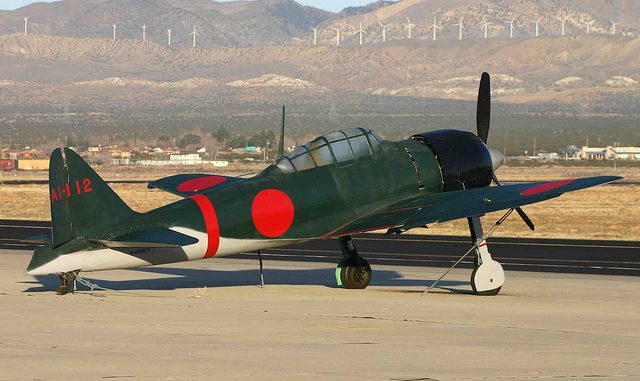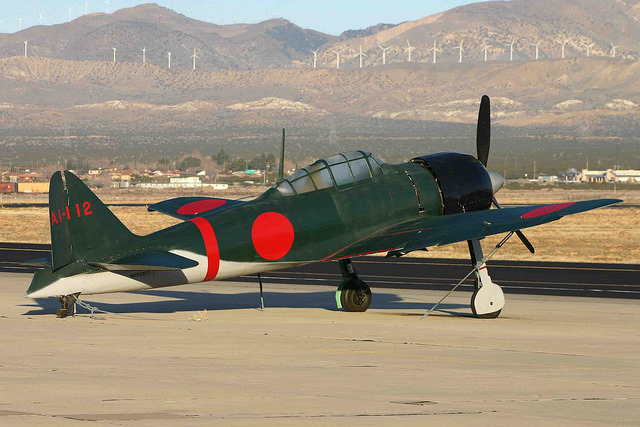

Earlier today, legendary Reno Air Racing pilot, Skip Holm flew a restored Mitsubishi A6M Zero over Japan. Although it is not the first former WWII-era Japanese aircraft to do so in the intervening seventy odd years since the end of the war, it is the first time a Japanese-owned example has gone aloft in that period, and this may have set a major new precedent in Japanese aviation policy. It should be noted that a couple of American-owned examples have made brief flying tours of Japan; most notably the former Planes of Fame Museum of Flying’s A6M Zero back in 1978 and again in 1995.
The aircraft is owned by Japanese businessman, Masahide Ishizuka, and has been in the country since September, 2014. The aircraft is based upon the remains of a wreck recovered from Babo Island in Indonesia by Bruce Fenstermmaker back in 1991, along with the hulks of a number of other Japanese warplanes. Its restoration took place over many years, beginning in Russia, where the major structural refabrication took place, and ending up in Mojave, California for final fitting and the installation of its powerplant. Little, if any original structure, other than the landing gear, made it into the restoration. Like all but one airworthy Zero, this example has a Pratt&Whitney R-1830 engine instead of the original Sakae.
The aircraft is currently based at Kanoya Maritime Self Defense Base in the Kagoshima Prefecture on the island of Kyushu… a base where wartime zeros once flew. It underwent its first engine runs after reassembly last July, but it took some time before the Japanese civil aviation authority would allow the aircraft to fly. It’s a sensitive subject, obviously, to bring back memories of Japans imperial past, but a thaw in those attitudes seems slowly to be occurring. One has to acknowledge the past, however painful, in order to move forwards, and perhaps that is what is now taking place in Japan.
The new owner commented in a recent interview with AP journalist Miki Toda that “I wanted for the people of Japan and especially young people to know about this Zero airplane, as well as those who are old who remember the past. Each of them should have different thoughts and perspectives on this, but I just want people to know how Japan has developed its technology.”
It will be interesting to see what happens now in the vintage aviation scene in Japan. Perhaps, like Germany over the last few years, there will be a renaissance of sorts which will see more wartime aircraft restored to flight again. It should be a good thing.
Skip Holm’s test flight with the Zero in Japan is seen in the video below.



Planes of Fames Zero also visited Japan in the last couple years as well. Upon return it was put down for extensive overhaul. So actually it has been to Japan 3 times since 78.
Also, Planes of Fame sold a flyable fighter to Japan in the 1970’s which flew several times in Japan but has not flown in recent years. I believe it was a Ki-84 Frank off the top of my head but I’d have to dig into my library to be sure of the model.
What great news! That makes four flyers in the world!!! 🙂 Congratulations!
Actually there are 5. Texas Flying Legends’, CAF’s, Planes of Fame’s, Flying Heritage Collection’s, and this one (seen in 3 ship formation at Planes of Fame airshow either last year or the year before). Also, Flight Magic is currently restoring another one.
One would hop the blueprints exist for the original Sakae engine. Some millionaire – Masahide Ishizuka? should do so. Isn’t there one in the states with the original engine?
Yes, there is. The original Sakae engine, and airworthy.
Yes. The Zero from the Planes of Fame Museum in Chino, CA has an original Sakae engine. It’s the only one in the world.
http://youtu.be/ZuoVlQOO4xc
Couldn’t they take the Sakae engine apart and scan all the parts with a 3D scanner? With the scan they should be able to crank out all the parts on CnC operated machines. Say run of 25-50 new engines while you’re at it.
Of course this is possible, with a lot of additional research involved besides just machining the parts… metallurgy and temper and other considerations abound, as do the issues with corrosion of parts beyond recognition. You can understand how such an undertaking would come at an astronomical price… so in comparison, the largely similar performance and ready availability of the reasonably priced R-1830 makes a much more practical solution. The demand for 25-50 new Sakaes simply does not exist either… at least not in the present day, as there are a mere handful of Zeros in flying condition, and even fewer available for rebuild. Even so, I’d love to see new-build engines come about some day… much like the new-build, though far less sophisticated WWI aero engines being manufactured in New Zealand by The Vintage Aviator.